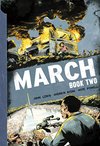Sublime
An inspiration engine for ideas


He was as important to the founding of a modern and multiethnic twentieth- and twenty-first century America as Thomas Jefferson and James Madison and Samuel Adams were to the creation of the republic in the eighteenth century. This is not hyperbole. It is fact—observable, discernible, undeniable fact.
Jon Meacham • His Truth Is Marching On: John Lewis and the Power of Hope
the Selma march, Lewis recalled, “injected something very special into the soul and the heart and the veins of America. It said, in effect, that we must humanize our social and political and economic structure. When people saw what happened on that bridge, there was a sense of revulsion all over America.” Revulsion, then redemption: Is there
... See moreJon Meacham • His Truth Is Marching On: John Lewis and the Power of Hope
Lewis’s was a vision of nonviolent social change that has more in common with the martyrs of old than with the politics of a given hour. “At the moment when I was hit on the bridge and began to fall,” Lewis recalled, “I really thought it was my last protest, my last march. I thought I saw death, and I thought, ‘It’s okay, it’s all right—I am doing
... See moreJon Meacham • The Soul of America: The Battle for Our Better Angels


For many Americans, especially non-Christians, the thought that Christian morality can be a useful guide to much of anything is risible, particularly since so many white evangelicals from 2016 forward chose to throw in their lot with a solipsistic American president who bullies, boasts, and sneers. Yet Lewis’s life suggests that religiously
... See more